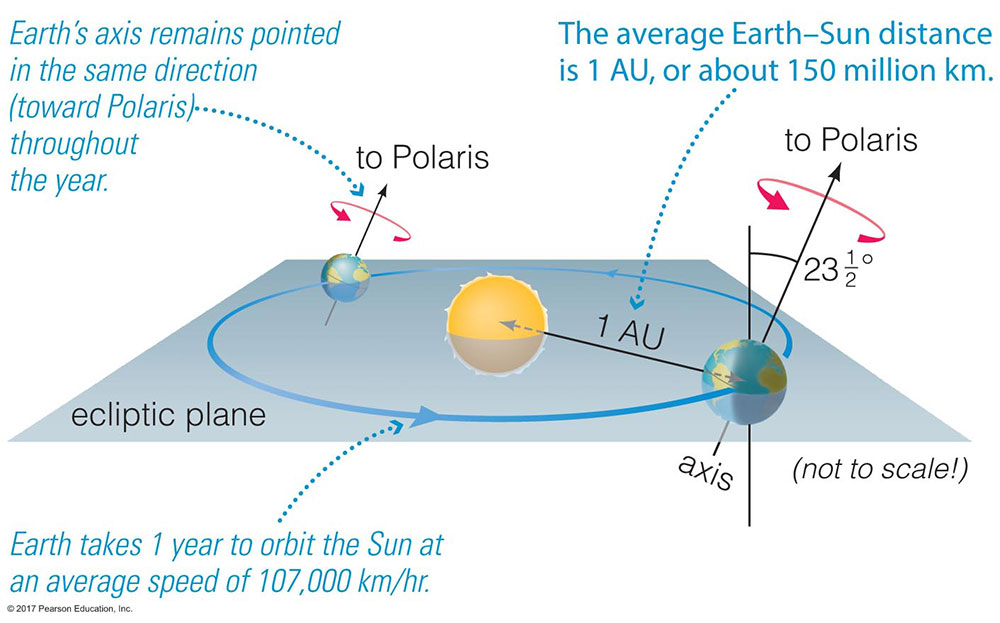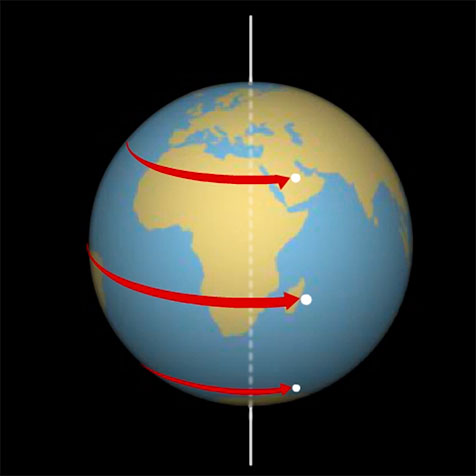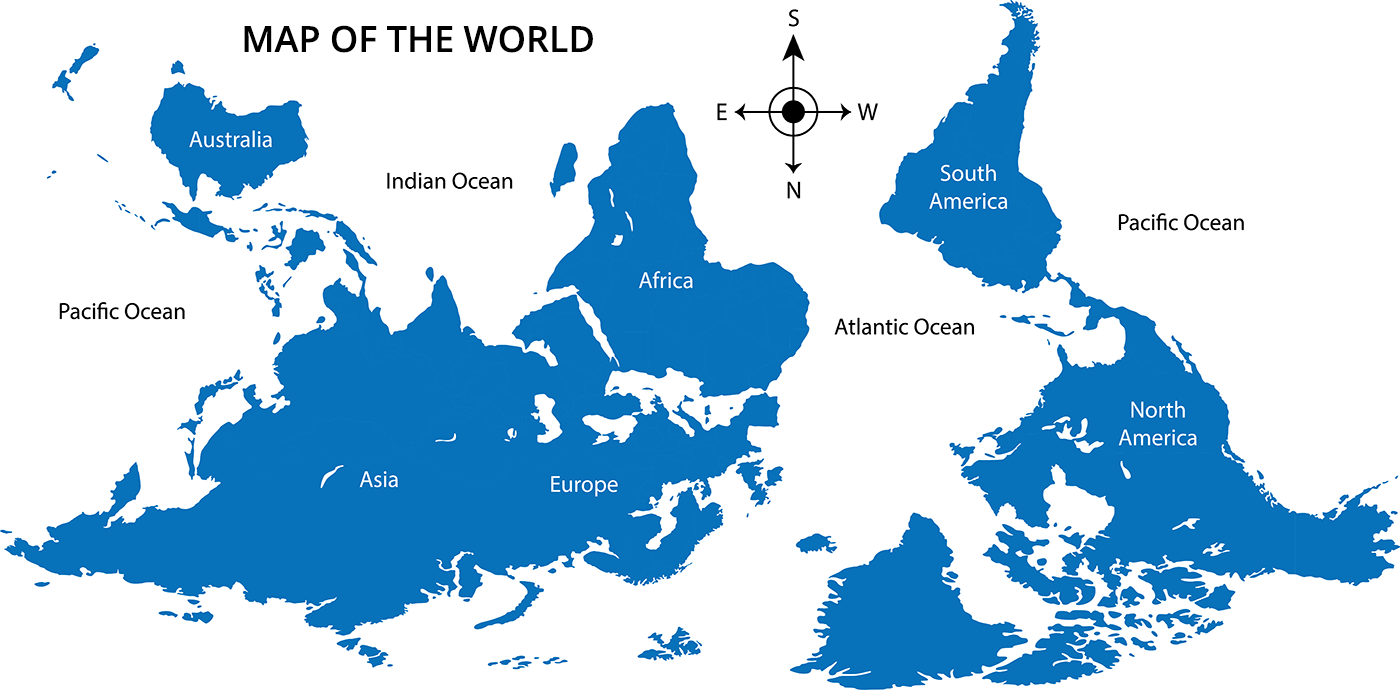Earth moves within our solar system in two major ways:
- Earth rotates (spins) on its axis once each day.
- Earth orbits around the Sun once each year.
Let’s consider each of these motions in a little more detail.
Rotation
Watch again the video you saw earlier of Earth rotating in space, and this time pay attention to the direction that Earth rotates. Notice that in this video, west is to the left and east is to the right, so we see that Earth rotates from west to east (which means counterclockwise as viewed from above the North Pole). Therefore, from our viewpoint on the ground, objects in the sky appear to move in the opposite direction, which means from east to west. That is why the Sun appears to rise in the east and set in the west each day.
Video
Viewing the Earth’s Rotation from Space
This the same video you saw earlier of Earth rotating in space. Notice that Earth rotates from west to east, which is why we see the Sun rise in the east and set in the west each day.
Activity
sunrise, sunset
Step 1: Darken your classroom as much as possible (or go to a room that darkens more) and set a lamp on a table.
Step 2: Hold a video camera (or smart phone with video). Start by holding the video aimed at the lamp, then rotate slowly around at least twice while still recording.
Step 3: Now watch your video and discuss. Does the video make it look like you were moving or that the lamp was moving? How does this relate to why we see the Sun rise and set as Earth rotates each day?
Step 4: Discuss: Do other objects in our sky, such as the Moon, planets, and stars, also rise and set each day? Why or why not?
This activity is designed to show students that if they record a video while rotating, the object(s) they are recording will seem to be moving when they replay the video. This is analogous to why Earth’s daily rotation caused the Sun to appear to rise and set in our sky.
- This works well with smart phone cameras set to video, and if your students have smart phones, they can all do the same activity so each student sees it for him/herself. Fyi, the reason we suggest the darkened room is so that the video will show only see the bright lamp; in a brighter room, the presence of other objects will distract from the point that the lamp seems to move when you watch the video, even though it was you (or the student) rotating as you made the video.
- For the discussion in step 4: The correct answer is that all these objects appear to rise in the east and set in the west for the same reason our Sun does — their apparent sky motion is a simple consequence of Earth’s rotation. The only object that can appear to move differently are human-made satellites in low-Earth orbit, which can appear to move through the sky in other directions because there are orbiting Earth faster than Earth is rotating.
Key Concepts: Earth Rotates
We see the Sun, Moon, planets and stars all appear to move across our sky each day only because we are looking at them from our rotating Earth. Because Earth rotates from west to east, these objects appear to move in the opposite direction, rising in the east and setting in the west.
It’s worth noting that we are moving surprisingly fast as a result of Earth’s rotation. Your exact speed depends on where you live, but as Figure 1.26 shows, most of us are traveling around Earth’s axis at a speed of more than 1,000 kilometers per hour (600 miles per hour), which is faster than the speed at which most airplanes travel.

Given those high speeds, you might wonder why we don’t feel ourselves moving on the rotating Earth. After all, if you ride on a fast-moving merry-go-round, you’ll feel yourself being “flung off” unless you hold on tightly. The answer comes from a combination of two main factors. The first is time. Even though Earth’s rotation is carrying us around the axis at a fairly high speed, it still takes a full day to complete one rotation. That’s much longer than it takes a merry-go-round to rotate, and this means that any feeling of being “flung off” is much weaker for Earth than for the merry-go-round. The second is gravity. The downward force with which Earth’s gravity holds us to the ground is much stronger than the outward force we feel from being “flung off” with Earth’s rotation (more technically called a centrifugal force). Together, the strength of Earth's gravity and the long rotation period counteract any feeling of being “flung off” that we might otherwise have, explaining why we don’t feel Earth’s motion.
Note that the same idea explains why Earth’s atmosphere rotates along with Earth: Gravity is what prevents the air in our atmosphere from escaping into space, and this means the atmosphere rotates along with the rest of our planet.
Do the Math
How fast is a person on Earth’s equator moving with Earth’s rotation?
Step 1 Understand: The question how fast tells us we are looking for a speed. If you remember that highway speeds are posted in miles (or kilometers) per hour, you’ll realize that speed is a distance (such as miles) divided by a time (such as hours). In this case, the distance is the distance that a person at the equator travels with each rotation, which is Earth’s equatorial circumference; if you look it up, you’ll find that this is 40,074 kilometers. The time is 24 hours, because that is how long each rotation takes.
Step 2 Solve: We divide the distance by the time of 24 hours:

Step 3 Explain: A person at the equator is moving with Earth’s rotation at a speed of about 1,670 kilometers per hour, which is a little over 1,000 miles per hour, or about twice the flying speed of a commercial jet.
Orbit
Earth also orbits the Sun, completing one orbit each year. The orbit is not quite a perfect circle (rather, it is a oval-like shape called an ellipse), but it is close. We’ll therefore think of it as being nearly a circle with the Sun at the center. You already know that the distance from Earth to the Sun is called one astronomical unit (AU), which is about 150 million kilometers. Figure 1.28 shows a diagram of the orbit. Notice two other key ideas:
- Earth’s orbital path defines a flat plane, called the ecliptic plane.
- Earth’s axis is not straight up and down compared to the ecliptic plane; rather, it is tilted by 23½°. This tilt happens to keep Earth’s axis pointed in the direction of a star called Polaris, or the North Star. As we’ll discuss in Chapter 2, the fact that Earth’s axis is tilted explains why we have seasons.

Link
 This video summarizes key ideas about Earth’s rotation and orbit. Credit: Video created for The Cosmic Perspective.
This video summarizes key ideas about Earth’s rotation and orbit. Credit: Video created for The Cosmic Perspective.
Video
Much as with rotation, we don’t feel Earth’s speed as it goes around the Sun, but the speed is quite impressive: We are racing around the Sun at a speed in excess of 100,000 kilometers per hour (60,000 miles per hour).
Remember also that Earth is not orbiting the Sun alone, but is accompanied at all times by our Moon. We’ll discuss the Moon’s orbit around Earth when we get to Moon phases in Chapter 2.
I was wondering…
Why does Earth rotate and orbit?
A key clue to understanding why Earth rotates and orbits comes from the fact that both go in the same direction: counterclockwise as viewed from above the North Pole. In fact, all the other planets also orbit Sun in this same direction and nearly in the same plane as Earth, and most also rotate in this direction. Careful scientific study of these and other aspects of motion in our solar system, along with studies of other star systems, has provided strong evidence that Earth and the other planets were born in a spinning disk of gas that surrounded our Sun when it was young. The planets all still orbit in the same direction as the disk was spinning, and most — including Earth — ended up rotating in this same direction as well.
Activity
What’s Up?
The diagrams on these pages make it look like north is “up” and south is “down.” But does that make any sense? Break into small groups and discuss the following questions, then regroup as a class so that your teacher can help you come to a class consensus.
-
- What determines the direction in which a river flows? Does it have anything to do with north and south?
- Point up and then point down. If you were to draw arrows representing your “up” and “down” on a globe, which directions would they point?
- Based on your answers so far, is there any such thing as “up” and “down” in space? Why or why not?
- Look at this map that has south at the top. Is there anything “wrong” with it?

Figure 1.29 – This world map has south at the top and north at the bottom - Overall, is there any scientific reason to show north as up and south as down? Can you think of any other reason why maps are usually drawn this way?
You may need to guide the students in their small group discussions as well as in the full class discussion that follows. Here are some discussion points to consider.
- Question 1: Students should realize that rivers flow downhill, which means their direction of flow is determined by changes in altitude. In other words, the flow of rivers depends only on local topography, not on cardinal directions (north/south/east/west).
- Question 2: Up and down are determined locally: Up is away from the center of the Earth and down is toward it.
- Question 3: The concepts of “up” and “down” are determined by the action of gravity on a planet’s surface. As a result, there is no up or down in space.
- Question 4: The “upside down” map is perfectly valid; these are popular in places like Australia that are in the Southern Hemisphere.
- Question 5: There is no scientific reason to show north as up and south as down, and a map or globe would be equally valid in any other orientation. There is, however, a historical/sociological reason that maps are usually drawn in this way: Modern maps and globes were developed and sold primarily by people who lived in the Northern Hemisphere, and they presumably put north on top as an assertion of priority. If you are curious for more information about how maps ended up with north on top, see this excellent article.
Do the Math
How fast is Earth orbiting the Sun?
Step 1 Understand: We are again asked how fast and therefore need to divide a distance by a time to find a speed. In this case, the distance is the circumference of Earth’s orbit, and the time is the 1 year that Earth takes to complete each orbit. If you’ve learned about circles, you know the circumference of a circle is given by the formula 2 x π x radius ; in this case, since the “circle” is Earth’s orbit around the Sun, the radius is Earth’s average distance from the Sun, which is 1 AU, or about 150 million km. So the formula we need to answer the question is this:

Step 2 Solve: We put in the numbers and carry out the calculation on a calculator, while also converting 1 year into hours so that we’ll end up with units of km/hr:

Step 3 Explain: Earth orbits the Sun at an average speed of about 107,000 km/hr (66,000 mi/hr). Most “speeding bullets” travel between about 500 and 1,000 km/hr, so Earth’s orbital speed is more than 100 times that of a speeding bullet.